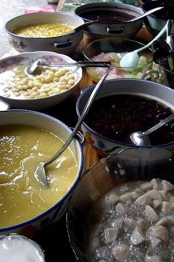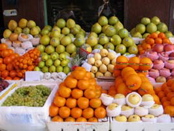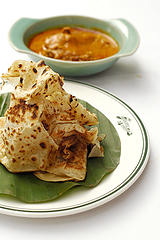
‘Sentral biryani handover’ by David Hagerman
Take one former graphic designer, a retired corporate banking and management consultant, a civil servant, a teacher, an amateur photographer, an academic and a freelance journalist. Add generous dollops of blogging software, several digital cameras, a sprinkling of enthusiastic assistants/partners and a few web-hosting accounts. Stir them together and you get some of the best writing about Southeast Asian food this side of the printed page.
Food blogs have always been a popular blogging genre, one that was for a long time characterized by foodlovers reviewing restaurants, recording recipes or reporting their obsessions with certain foods, such as cupcakes or “crazy Asian drinks.” But the genre has since those fizzy days aged, matured and acquired complexity and depth. Now there are food bloggers who go beyond recipe records and reviews to inquiring into ingredients, interacting with cooks and discovering the stories and cultures behind the dishes. In Southeast Asia, many food bloggers can be found outside of the kitchen and out in the street: sampling food at the roadside stalls, wandering carts or wet market counters from which most ordinary Southeast Asians draw their daily sustenance.
Here is a taste of some of the Web-only delicacies cooked up from our region:
Robyn Eckhardt started EatingAsia after moving to Kuala Lumpur from Saigon (and before that Hong Kong, Shanghai, Nanjing and Bangkok). “I have been a food lover for as long as I can remember,” she confesses. “Even if I weren't blogging you'd find me at the wet market, or tracking down some street stall specializing in a certain something.” Among her posts, illustrated by photos taken by her husband: comparing noodle soups, searching for fiddlehead ferns and sampling Sichuan food in KL.
Her approach to food emerges from her background as an researcher. She's interested in history and tradition, social and cultural context, and emotions. “I'm fascinated by the fact that so much prepared food in Asia is still “artisanal” — one guy with one wok making one dish, over and over, for years and years, maybe even taking over from his father who made it for years and years before that,” she says. “That's history, that's tradition, that's a marker of a unique culture.”
 Eckhardt says she started blogging about food only after leaving Saigon, since she felt there was little she could add to that Noodlepie hadn't already covered. Graham Holliday's Saigon-based site is perhaps the best-known food blog outside the region, with mentions in the Observer, the San Francisco Chronicle and the New York Times. The British-born freelance journalist, who came up with the moniker “noodlepie” as an east-meets-west name, started the blog as a “keepsake” — a way of recording his time sampling Saigon's food with his spouse. “The fact that it's open to everyone has given it a different life.”
Eckhardt says she started blogging about food only after leaving Saigon, since she felt there was little she could add to that Noodlepie hadn't already covered. Graham Holliday's Saigon-based site is perhaps the best-known food blog outside the region, with mentions in the Observer, the San Francisco Chronicle and the New York Times. The British-born freelance journalist, who came up with the moniker “noodlepie” as an east-meets-west name, started the blog as a “keepsake” — a way of recording his time sampling Saigon's food with his spouse. “The fact that it's open to everyone has given it a different life.”
Graham had been inspired by a now-defunct food blog out of South Korea, Fatman Seoul. “Over time I've come to appreciate how sites like noodlepie can work as decent little niche resources,” he told me. “Also, I think good blogs can really get under the skin of a place far better than guidebooks or even the local press can. I'm not a food expert, or fluent in Vietnamese, but I hope I've nudged open a door into this world that most non-Vietnamese know very little about. I quite like the thought that I'm bringing little pockets of life from the streets of Saigon into people's homes all over the world.”
Up in Hanoi, Stickyrice, like EatingAsia, also drew its initial inspiration from Noodlepie. “There’s a story in nearly every meal, particularly at street level,” says Mark Lowerson, who along with Kate Henry, comprise the two-Australian team behind the blog, which bills itself as “food news, restaurant reviews and street-food docudrama.”
“I think the situation in VN (and I’m sure many other Asian countries) lends itself to the yarn behind the food; the process of watching the food prepared or the interaction between the people, even the journey. In our sanitized western world, we miss out on all of that when we go out to ea… Here, all the habits of kitchen employees – good or bad – are exposed for all to see. As Kate said in our rather brief ABOUT page, it’s about the food but observing the people is at least half the fun.”
Both bloggers have different preferences: Kate enjoys the local restaurant scene, while Mark, who describes himself as “more of a tightarse,” goes for “the street stalls and one dish wonder places,” where there's little accomodation for Western tastes. “At these places, you also see real Vietnamese people not putting on any airs or graces,” he tells me. “They fix their shoes, then serve the food. Sometimes, I actually find myself eating in their bedroom. I love it.”
Love also lies behind the Filipino blog Market Manila: love of food. The pseudonymous Market Man confesses he might have attended hotel or culinary management school but instead opted to take the practical, high-paying path of corporate banking and management consulting. Now in his late 30s and semi-retired in Manila, Market Man often takes a route rarely seen in the foodblog world: covering markets as well as food, from the Central Public Market on the island of Bohol to a Sunday market in Manila's business district of Makati. Market Man is also extremely interested in produce. “To cook well, you need the proper ingredients, so I must do the markets, I must talk about the produce and who grows it and what it tastes like. I do want readers to learn something about sources, ways to buy produce, clean it, store it. I learn a lot in the process and hopefully readers will too.”
 Unlike EatingAsia, Noodlepie and Stickyrice, Market Manila has recipes as well. “Recipes are what really get hits and repeated ones at that…This is also a way for me to document my own favorite recipes and to to make things I grew up with but never cooked myself. Fewer people are truly interested in the history behind a particular plant, or the slight difference between one rice or the other.” (Don't fear, though, because Market Man is!)
Unlike EatingAsia, Noodlepie and Stickyrice, Market Manila has recipes as well. “Recipes are what really get hits and repeated ones at that…This is also a way for me to document my own favorite recipes and to to make things I grew up with but never cooked myself. Fewer people are truly interested in the history behind a particular plant, or the slight difference between one rice or the other.” (Don't fear, though, because Market Man is!)
The final food blog featured here is Singapore's Chubby Hubby. It looks the slickest, perhaps because its author, Aun Koh, is a former magazine editor and current food photographer and his wife is a professional food writer. (Together, he confesses, they own over 320 cookbooks and have bought industrial-strength equipment for their tiny kitchen.) Like the rest, though, he started blogging as an experiment.
“I pretty much hung up my journalist's cap a couple of years ago,” he says. “And while I enjoy my current work (working as a civil servant in arts development), I missed writing, especially on lifestyle topics that interest me…Blogging allows me to fulfill my need to write regularly. And because you aren't writing for anyone other than yourself…You don't have to worry about editors, deadlines, and all the other things that make journalistic writing sometimes less than fun.” Aun, who is a voracious consumer of food magazines, even says, “In fact, as food blogs get better and better, I see the need to read these print magazines less and less.” Like the others, too, Aun has read a lot of other people's food blogs:
“What I find most interesting is the stories of what and how we eat…My wife and I love going to markets; we love finding the sources of great foods. One of our favorite trips involve finding a small, family-run belachan maker and a home-grown soya sauce brewer in Penang. The quality of both the belachan and the soy sauce were so much better than any factory-made products. But we also love eating in fancy restaurants, being spoilt to death in places like Le Cinq in Paris. We love all food, simple and the super-sexy. And I'm happy to write about either.”
 The foodbloggers report that they've been surprised by the depth and intensity of reactions from readers. Graham says that he gets a lot of email from overseas Vietnamese (“Viet Kieu”). One Viet Kieu woman recognized a street stall he had once blogged, which sold fried-egg-filled baguettes. “She used to eat breakfast there every day. She just wanted to thank me for reminding her of her hometown.” Market Man also reports that he has been “truly overwhelmed by reader reaction.” The millions of Filipinos who work abroad “miss home, and they miss the food. They have romanticized a lot of the dishes and experiences they had when they lived here and the blog brings back memories.” Eckhardt reports the same phenomenon from EatingAsia‘s Viet Kieu and overseas Malaysian readers.
The foodbloggers report that they've been surprised by the depth and intensity of reactions from readers. Graham says that he gets a lot of email from overseas Vietnamese (“Viet Kieu”). One Viet Kieu woman recognized a street stall he had once blogged, which sold fried-egg-filled baguettes. “She used to eat breakfast there every day. She just wanted to thank me for reminding her of her hometown.” Market Man also reports that he has been “truly overwhelmed by reader reaction.” The millions of Filipinos who work abroad “miss home, and they miss the food. They have romanticized a lot of the dishes and experiences they had when they lived here and the blog brings back memories.” Eckhardt reports the same phenomenon from EatingAsia‘s Viet Kieu and overseas Malaysian readers.
Their blogging has also had effects on the stalls and eateries that they've covered. “Some stalls I have featured have experienced 50-75% increases in sales in the weeks after being featured,” says Market Man. The bloggers behind Stickyrice also have heard that the vendors they've covered have seen more and more foreigners sitting down on the plastic stools to try the food. Victor's Kitchen, a small dim sum place Chubby Hubby raved about, printed out Aun's post and pasted it in their window.
All say that the medium has enabled them to connect to readers. Market Man points out:
“What differentiates a food blog from say a food magazine is that you know this one individual is doing it all himself or herself. If they don't take advertising, or somehow making money out of it, they are doing it solely out of interest, passion, desire, whatever…Many readers feel “attached” to the site. I also have to say that I feed off of reader comments. Most people don't realize this but the comments bring a whole new dimension to a blog. If more readers would participate, blogs would get even better.”
Says Aun: “One person in particular sent a really amazing email, saying that my blog had gotten her really excited for the first time in years about eating. It's great to be able to touch someone that way, especially when you never had that intention when you started the project.”
Oh, and have these bloggers gained weight since starting their blogs? Most report that their lifestyles keep them thin — which allows them, so to speak, to have their cake and eat it too.
Photo credits (in-text photos):
‘che treats’ by stickychopsticks
‘Fruit stalls on Salazar Street, Manila’ by Market Man
‘prata_raffles’ by Chubby Hubby







12 comments
this makes me miss asian food very much… living abroad and only get to go home once in a (long) while, i have to make do with what i can find here but they are just not the same…
Lil – having lived in Asia a while I would have to agree. I never go to Vietnamese restos in the UK. It’s a totally different deal. Not that it’s so bad, it’s just too different from what I know. I guess the lesson is eat local wherever you are. Even if that means dining on putrified shark in Iceland. Yes. Really.
I’ll say it again here. I think Jose did a grand job with this post.
Great article Joel! Happy New Year from Panama :)
Really nice read, our food blog here is hardly as well planned as yours.Best wishes from the US Joel.
Thanks for the mention of my blog: 52 cupcakes in this post. It is, however, a little more than a site of obsession…it started out as a way for me…a non-cook…to test my mettle as a baker…for 52 weeks straight…a different cupcake every week. You missed my photo blog spawned by my year-long baking project: a new photography career. Here’s the link: flickr photos.
What an interesting site, and I commend you on it. I had a good time reading through the various Asian culinary delights. I am covering another aspect, commenting on a mix of both Western and Asian restaurant cooking in Asia. It is a work in progress and will continue. http:restaurantdiningcritiques.typepad.com Have a look!
Good food habits!! No one can deny the role of good food for a healthy life. At good food tips we will try and provide you information on how to maintain these good food habits. Tips on how to utilize the most general of the fruits and vegetables to cure diseases maintain weight etc……………….
http://www.letsgoeat.co.uk.